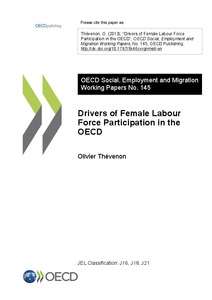Drivers of female Labour force participation in the OECD

Organisation for Economic Co-operation and Development, Paris
OECD Publishing - Paris
2013
58 p.
child care ; labour force participation ; women workers ; women ; work-life balance
OECD Social, Employment and Migration Working Papers
145
Gender equality & Women
http://dx.doi.org/10.1787/5k46cvrgnms6-en
English
Bibliogr.
"This paper analyses the response of female labour force participation to the evolution of labour markets and policies supporting the reconciliation of work and family life. Using country-level data from the early 1980s for 18 OECD countries, we estimate the influence of labour market and institutional characteristics on female labour force participation, and full-time and part-time employment participation. The relationship (interactions, complementarity) between different policy measures is also analyzed, as well as potential variations in the influence of policies across different Welfare regimes. The results first highlight how the increase in female educational attainment, the expansion of the service sector the increase in parttime employment opportunities have boosted women's participation in the labour force. By contrast, there is no such clear relationship between female employment rates and the growing share of public employment. Employment rates react to changes in tax rates, in leave policies, but the rising provision of childcare formal services to working parents with children not yet three years old is a main policy driver of female labour force participation. Different policy instruments interact with each other to improve overall effectiveness. In particular, the coverage of childcare services is found to have a greater effect on women's participation in the labour market in countries with relatively high degrees of employment protection. The effect of childcare services on female full-time employment is particularly strong in Anglophone and Nordic countries. In all, the findings suggest that the effect of childcare services on female employment is stronger in the presence of other measures supporting working mothers (as, for instance paid parental leave) while the presence of such supports seems to reduce the effectiveness of financial incentives to work for second earners. The effect of cash benefits for families and the duration of paid leave on female labour force participation also vary across welfare regimes."
Digital
The ETUI is co-funded by the European Union. Views and opinions expressed are however those of the author(s) only and do not necessarily reflect those of the European Union or the ETUI.